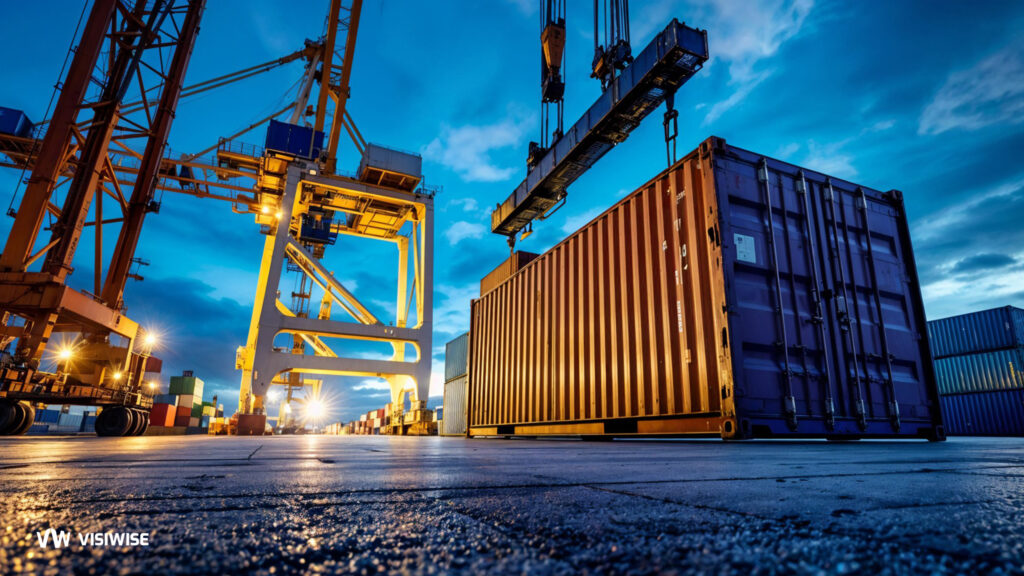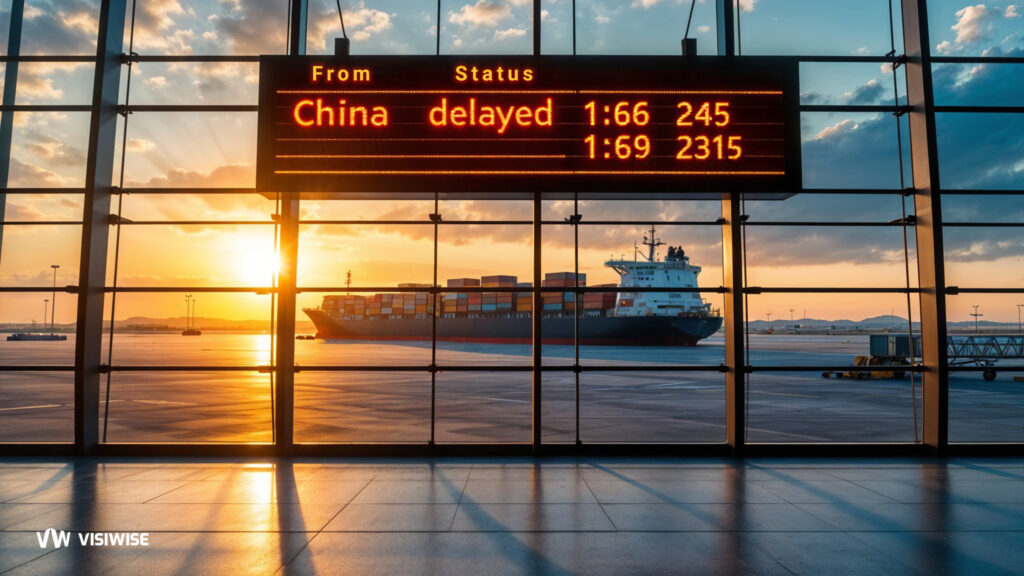Shipping containers are the life force of the global trade, bearing anything from gadgets and apparel to raw materials. As these ships get bigger and bigger, the question becomes: how long does it actually take to unload a container ship? The answer to that depends on many factors, e.g., the size of the ship, the port infrastructure, and the technology. In this article, we will explore the process of unloading and how the ports of the world cope with this critical work.
Container Handling Operations
Three main subsystems at container terminals are the waterside (vessel to quay), stacking yard (container storage), and intermodal (land transport). Choosing handling equipment relies on terminal size, layout, container type (empty or laden), and operation flexibility.
Challenges in the Global Container Terminal Sector
Container terminals must modernize to meet future demands. Key challenges and responses include:
- Bigger Ships Need Larger Cranes
It is a fact to be acknowledged that container ships have grown threefold in size over the past 70 years and are now even at the level of 23,000 TEUs. For ports to cope with the situation they need to not only be capable of deepening berths and strengthening quays but also expanding the equipment such as ship-to-shore cranes by means of raising booms. It is still an open question what is more economically viable: retrofitting or replacement of cranes depending on the factors such as the old cranes, their obsolescence, or the amount of time they were out of service. The process of raising a crane is really expensive, it is around €1.2 m and it takes 6-10 weeks. - Boosting Quay Productivity
Larger port calls (up to 6,000 TEUs) increase pressure to speed up operations. Due to crane spacing limits, each crane’s productivity (20–30 moves/hour) is crucial. This can improve to 40–70 moves/hour with systems like multiple spreaders or secondary trolleys. - Stacking Yard Optimization
Yard space can’t expand as fast as quay productivity. Operators aim to raise stacking density and cut storage time. Traditional stacking (5–6 high) is evolving with multi-storey systems—each container in an individual rack—boosting capacity by 200% and improving speed, energy use, and safety. Adoption requires full terminal layout reconfiguration. - Sustainability via Electrification
Eco-friendly terminal trends drive adoption of low-impact tech—reducing noise, dust, vibration, and CO₂. Electrified RTGs (vs. diesel) lower emissions and noise. Yard upgrades are needed to power these systems. - Intelligent Transport Systems To handle traffic growth and maintain quality, terminals are adopting smart transport tech: driverless trucks, remote cranes, AGVs, automated mooring, and even underground transport to avoid traffic crossings.
Typical Unloading Durations of a Cargo Ship
Typically, unloading a cargo ship takes about 1 to 3 days. This timeframe is mainly due to the fact that many ships carry over 10,000 containers!
The unloading duration at a seaport really hinges on the ship’s capacity, which is often measured in TEUs (twenty-foot equivalent units).
Let’s say it takes roughly 2-3 minutes for a crane to lift each container off the ship. If four cranes are working simultaneously at the port, we can estimate the unloading time for various ships:
- Feeder Ship (1500 TEUs): 15-16 hours
- Panamax (4500 TEUs): 1-2 days
- Post Panamax (6400 TEUs): 2-3 days
- Suezmax (12000 TEUs): 4-5 days
- Post-Suezmax (18000 TEUs): 7-8 days
Container ships typically do not load the maximum number of containers all at once. During each port visit, the ship unloads empty containers. It then reloads some import and export containers before moving to the next location. This leads to time spent on unloading and loading containers at each port, causing delays.
Factors Affecting Efficiency of Unloading and Port Drayage Operations
From managing the complexities of ocean freight logistics to coordinating container drayage, shippers encounter many pain points that can delay timelines and affect the supply chain. When you ask, “How long will it take to unload a container ship? —the response is influenced by an array of interdependent factors. Here is a detailed overview of the critical factors that impact unloading and port drayage operations.
Berthing and Crane Availability and Capacity
The speed of unloading of a ship is directly related to the number of cranes available at any particular port and berth. Where modern ports often have several high-capacity cranes that can unload multiple containers at a time, smaller or underfunded ports may have bottlenecks due to insufficient equipment. Crane efficiency, technology and automation capabilities also play critical roles in how rapidly cargo is moved from a vessel.
Extreme Weather Events and Environmental Disruption
Port operations can be hindered by adverse weather conditions such as storms, high winds, heavy rain, or fog, resulting in considerable delays. Safety protocols frequently stop unloading during bad weather, creating backlogs. Seasonal disruptions such as hurricanes or monsoons must also be taken into account when scheduling routes and timelines.
Port Equipment Asset Condition and Maintenance
Ports depend a great deal on myriad machinery — cranes, forklifts, yard tractors. Equipment reliability is ensured by routine maintenance and performing upgrades at the right time. Malfunctions or legacy systems slow operations but can also create safety hazards that further delay container handling.
Availability of Port Labor
The unloading process can be affected heavily by labor shortages. Dock workers, their rotating shifts and union-related agreements all dictate the pace of operations. Ports with a shortage of skilled labor may see slower unloading speeds and longer vessel turnaround times.
Skill and Experience of Port Workers
Experienced dock workers and port staff who expertly handle containers and are familiar with customs clearance, particularly for delicate or high-value cargo. They know specific types of cargo, terminal layout and logistical systems and can improve overall performance and avoid mistakes or damages during an unloading process.
Specialized Drayage Services with Port Familiarity
Some ports are better tailored for certain types of containers or specialized drayage services. Ports that manage reefer containers (refrigerated) and hazard materials will be more efficient, while an unfamiliarity with these processes will create compliance issues and longer wait times for goods.
Also Read: What is Special Cargo Handling?
Unloading efficiency is also dependent on the type of cargo. Fragile, perishable, oversized or hazardous goods often need special handling, extra documentation or regulatory checks. These extra measures may lead to longer unloading times and disrupt the following drayage operation.
Availability of Drayage Truckers and Drivers
Additionally, the availability of truck drivers, who move freight out of the port, is critical, even once cargo is offloaded. If there’s a shortage of drayage truckers — especially those who have the right licenses or certifications to carry containers — it can leave containers sitting in the port, driving up storage costs and delaying final delivery.
The proximity and timing of Freight and Passenger Rail.
Rail access is a key efficiency factor in intermodal transport. Ports close to rail terminals and regular fixture shipping to inland points can accelerate the cargo movement. By contrast, bad rail scheduling or remote terminals can hinder the flow of goods.
Integration with Cross-Docking & Local Warehouse
The cross-docking operation allows for the direct transfer of cargo from a ship to a truck or a warehouse, reducing cargo time at the port. Ports that have sufficient warehousing infrastructure and cross-dock and real-time inventory systems streamline logistics and minimize delays related to drayage.
Dock Configuration and Accessibility
The physical layout of docks matter in subtle but significant ways. Having dry land on both sides of the ship’s berth permits quicker movement of equipment and vehicles. During peak shipping seasons, limited space or poorly designed infrastructure can greatly hinder operations.
Current Berth Availability & Vessel Queue Times
High-traffic ports generally have a limited number of berths for vessels waiting to arrive. That means ships might have to anchor offshore for hours — or even days — waiting for an available berth. Efficient scheduling and communication systems are helping to mitigate these delays, but in busy trade corridors, congestion is still a concern.
Case study: Port of Shanghai
Since its opening, the port has experienced significant benefits. The port increased compute and storage infrastructure performance by 200 percent to power new port automation software, with extra capacity for increased intelligence (AI). Handling efficiency has subsequently increased by 30 percent, saving 10 hours in the cargo unloading for the world’s biggest container ship. They have seen a 10 percent decrease in carbon emission, and have boosted the port’s standing as the busiest and most advanced automated container port in the world.
Final Thoughts
There are so many factors, which can reduce the unloading time of a cargo ship from a minimum of some hours to several days.
New, tech-driven ports have substantially decreased the time needed for the process, whereas some traditional ones are still unable to assist big ships with the unloading of the cargo.
Thanks to the growth of global trade, the speed of delivering the goods from one place to another will be fundamental in the decision of exporting/importing the goods.



